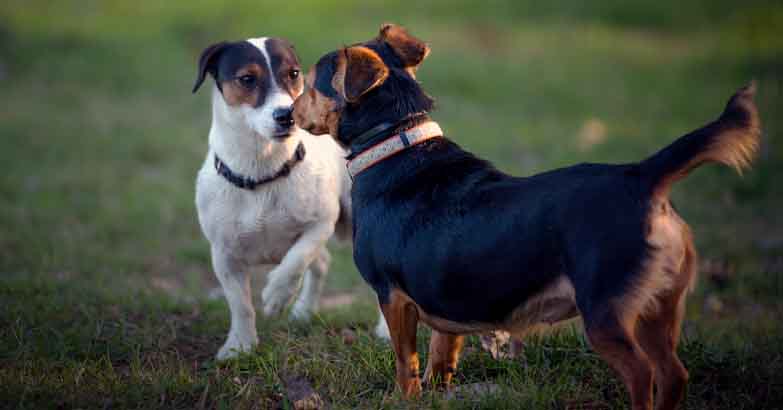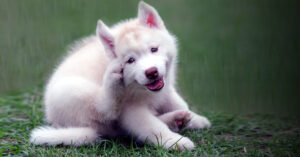Whether you’re introducing your dog to a new play friend or canine family member, or bringing a cat or a new baby home, you’ll need some patience and careful planning.
Here are a few helpful tips and tricks to make the introductions go smoothly.
How To Introduce Dogs To Each Other
Introducing dogs to each other is usually quite easy as long as they’re both well-socialized and used to interacting with other dogs. Some sociable dogs will meet other dogs and instantly start playing, while others may need more time to warm up to each other.
The steps below may involve more caution than you need for dogs who are used to meeting others in their neighborhood, so adjust your approach as appropriate.
- Pick a neutral spot, like a park with plenty of space to roam, or even the backyard of a neighbor who doesn’t have a dog. You’ll need a handler for each dog.
- With both dogs still on leash, let them see each other from a distance, or even from different sides of a fence.
- Watch for body language showing relaxed postures and tail wagging, and be alert for signs of tension like hard stares, standing tall, stiff bodies and tails, hard pricked ears … or even raised hackles or bared teeth. If you notice any tension or discomfort, move the dogs further away from each other. Praise and reward the dogs only when they give each other relaxed attention.
- Once they’re calm and relaxed, move them closer. If you’re in a large enough area, you can walk them in the same direction … keeping enough distance for them to stay relaxed and get used to each other.
- Next, it’s time for them to say hello. It’s often best to do this off-leash. You can leave the leashes attached, but drop them so you can grab them in case of a problem. This allows them the freedom to move away if they want, and avoids tension caused by the handler tightening on the leash.
- Don’t force interaction. If either of them isn’t interested, let him walk away and give him more time to warm up to the other dog.
- Keep sessions short at first, and keep watching their body language. You may see relaxed sniffing or a play bow … and they may start to play together.
- If either dog seems uncomfortable, move them away from each other. If they seem happy and playful, you can gradually increase their time together.
Just keep in mind that every pup has his own personality, and not all dogs will get along. So don’t rush the process. If one dog is uncomfortable or reactive, it’s best to get expert help.
RELATED: How to stop dog humping …
How To Introduce Dogs On Leash
If you prefer to introduce dogs to each other completely on leash, that can work too.
- Again, start out on neutral territory as explained earlier.
- If you can, walk both dogs on opposite sides of a wide path, allowing them to see each other from a distance. If they both seem comfortable, you can gradually reduce the distance between them.
- When it’s time for the dogs to meet, keep the leashes loose and avoid letting them pull towards each other. Again, watch their body language closely and be prepared to separate them if needed.
Remember that your dog is sensitive to your response, so try to keep calm during the introduction. Always reward your dog’s calm behavior with praise and treats.
Note: People also ask how to introduce dogs when one is aggressive. That’s a separate and much more complex topic, but in most cases it’s best to get professional help.
How To Introduce A New Puppy To Your Dog
Bringing a new puppy home is an exciting time. But it may be less exciting for your adult dog, especially if he’s used to being the “only child.”
- If you take your adult dog with you to pick up the puppy, make sure they travel separately in the car on the way home – in separate crates or different parts of the car.
- When you get home, start by introducing them outside, on leash.
- Walk them around the yard together, then let the two dogs sniff each other.
- As they start to interact, watch for body language like your adult dog raising his hackles or baring his teeth. If your dog shows these signs of discomfort around your puppy, you may need to take things slower.
- If your dog growls at the puppy, don’t scold or punish him. That’s how dogs communicate they don’t like something, and it will teach your puppy that he’s crossed a line and may have annoyed his “big brother.”
- However well they get along, give your adult dog gets breaks from the puppy so the youngster doesn’t pester him when he’s resting.
Even though puppies need a bit of extra attention, try give both dogs equal time to help prevent jealousy. Take the dogs on walks together so they get used to activities with each other. Give them supervised playtime together, but make sure both your adult and the puppy have their own separate space to rest and relax. Crate training your puppy from the start is a really good strategy.
Even if all goes smoothly, you’ll want to keep a close eye on them for up to a few weeks after the introduction, and separate them when they’re home alone.
RELATED: 5 tips for raising a puppy …
How To Introduce A Dog To A Cat
What if you decide to add a feline friend to your household, or you already have a cat and bring a new dog home? The good news is that with some patience and careful planning, your dog and cat can become best buds … or at least learn to coexist in peace!
- Keep your dog and cat separate for a few days, and make sure they each have their own private space (for example, your cat could stay in a bedroom where she has food, water, toys and a litter box).
- Give each of them time to roam the rest of the house alone so they don’t have to interact right away.
- Next, let your pets sniff each other’s belongings, toys or bedding to get to know each other’s scent. You can keep some cat toys or blankets in your dog’s area, and vice versa. This can take up to a few days or even a week, but it’s an important and helpful step.
- Once they’re comfortable with each other’s smell, you can start feeding them either side of a closed door.
- If they’re comfortable doing that, move on to a supervised introduction through a gate or screen door where they can see and sniff each other.
- When they meet face to face, choose a neutral location that neither pet has claimed as their territory. Keep your dog on a leash so you can control him around your cat, and use treats to reward calm behavior in both pets. Make sure to intervene and move your dog away if he starts to get too excited.
- Do this for a short time each day until they get used to each other, rewarding both with especially yummy treats.
Remember, patience is key. Some dogs and cats may become fast friends, while others may take weeks or even months to get along. Supervise them at all times and never leave them alone together until you’re absolutely certain they’re happy and relaxed around each other. Try not to let your dog chase your cat, or he may be tempted to repeat that fun activity!
How To Introduce A Dog To A Baby
Introducing a dog to a baby might seem daunting, but don’t worry, with patience and supervision, it’s totally doable. Even the most well-behaved dog may need time to adjust to the presence of a new baby.
- Before bringing the baby home, allow your dog to explore your baby’s sleeping area or room, and reward and praise him as he looks around.
- After your baby’s birth, let your dog get familiar with the baby’s scent before the actual introduction, by letting him sniff baby clothes or toys.
- Then you can progress to letting him sniff or watch the baby through crib bars or a baby gate. Let him get used to doing this calmly before you progress to a direct introduction,
- When it’s time for the actual introduction, keep your dog on a leash so you can remove him if necessary.
- Allow your dog to approach the baby gradually while using treats and praise for calm and gentle behavior. Pay close attention to your dog’s reactions and if he shows anxiety or over-excitement, calmly walk him away.
Make sure you’re relaxed too … if you’re anxious, your dog will pick up on that.
Never leave your dog unsupervised with your baby or small child, and teach your dog to be gentle and calm around your baby. Make sure your dog keeps his usual walk, play, exercise and meal routines, to help reduce stress from the new arrival.
Take it slow and adjust your approach as needed. If you need some extra help, don’t hesitate to call a professional for advice.
Bottom Line | How To Introduce Dogs
Introducing dogs can be a time-consuming process, but with patience and careful planning, you can make it a smooth one!











